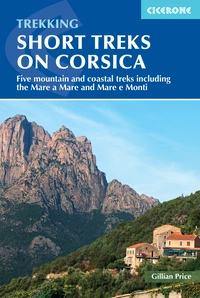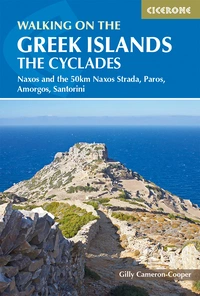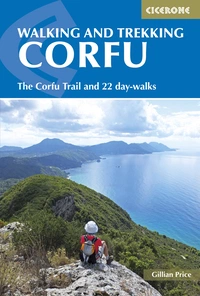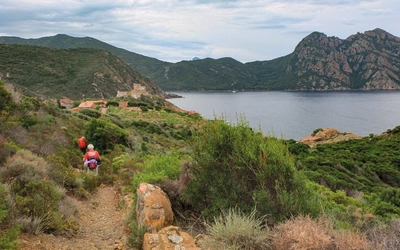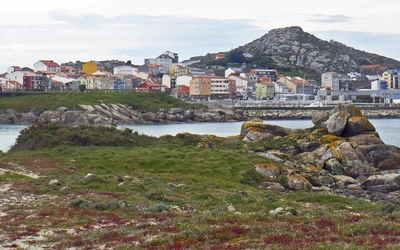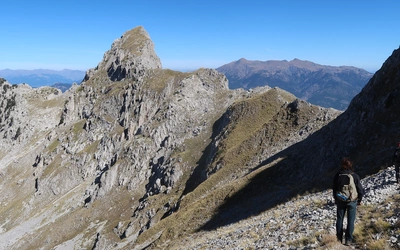Short Treks on Corsica: what you need to know
‘Trekking in Corsica? Wow! Of course, you mean the GR20!’ ‘Well, actually, no… Ever heard of the Mare e Monti or Mare a Mare Nord?’ South of Marseilles and worlds away from the French Riviera, the breathtaking Mediterranean island of Corsica is a paradise for walkers. Here is everything you need to know about five long-distance routes that criss-cross the island.
Short Treks on Corsica
Five mountain and coastal treks including the Mare a Mare and Mare e Monti
£16.95
Guidebook describing five mountain and coastal treks on the Mediterranean island of Corsica: the 2-day Sentier du Douanier (Custom Officer's Path), the 10-day Mare e Monti, the 11-day coast-to-coast Mare a Mare Nord, the 5-day Mare a Mare Sud and the 5-day Mare e Monti Sud. With information on facilities and local plants and wildlife.
More informationCorsica is best known for the challenging GR20, a route that is on the bucket list of walkers all over the world. But not everyone is up to carrying a heavily laden rucksack for two weeks – luckily the island is criss-crossed with routes that lend themselves to creative mixing and matching. Via rugged mountains linking the sparkling Tyrrhenian and Ligurian coasts, the five treks described below are all well signposted, waymarked and within the grasp of average walkers who prefer to go independently. Each stage concludes in a small village – this translates as good food and a comfortable bed, not to mention access to shops.
Trek accommodation usually means a gîte d’étape, that brilliant French invention that translates as a hostel for walkers with a choice of a comfortable dormitory with bunk beds or private rooms. You need to carry only a lightweight sleeping sheet and towel in your rucksack. The gîtes d’étape are mostly owned by local councils and managed by village residents who welcome walkers and prepare a hearty dîner (evening meal) as well as petit déjeuner (breakfast).
So, is there a downside to these treks? Well, the walking days can become inexplicably long if you’re easily distracted by magical coves where the turquoise sea beckons, or rocky river valleys where a waterside rest and picnic are must-dos, and then there are the marvellous Mediterranean flowers that cloak hillsides and seafronts with explosions of colour… Plus, despite the term ’short’ in the title of this article, two of these pedestrian journeys last 10 and 11 days. And last, be warned – these treks can be highly addictive: just one taste and you may find yourself coming back for more!

1. Sentier du Douanier
Where: Port de Centuri to Macinaggio
Distance: 24.4km
Ascent/descent: 800m
Time: 2 days
The Sentier du Douanier explores the island’s far north. Short and very sweet, it starts at the pretty fishing haven of Port de Centuri and traverses solitary headlands and coves on the two days it takes to round the elongated cape en route to Macinaggio. It’s on Cap Corse, the far northern tip of Corsica. There’s no denying it, on the map it looks like a thumb sticking out into the deep blue of the Mediterranean.
You spend two immensely rewarding days on a jaunt along the rugged coastline, from Port de Centuri in the west around to the eastern seaboard and Macinaggio. Make sure you have extra time up your sleeve to allow for distractions. Along the way you drop in on isolated fishing villages and photogenic 16th century watchtowers built to protect the communities from raiding pirates. The walk start is Port de Centuri and just happens to be France’s leading lobster fishery so maybe an overnight stay with dinner is in order?

2. Mare e Monti
Where: Calenzana to Cargèse
Distance: 122.6km
Ascent/descent: 6565m/6720m
Time: 10 days
Rather different in flavour is Mare e Monti which, as the name suggests, drops in and out of sea and mountain landscapes. It’s also longer – 10 days. Mare e Monti starts out at Calenzana near Calvi on the west coast, before climbing through the wonderful Bonifatu forest to the photogenic Fango river valley, a canyon crossed by an elegant Genoese stone bridge.
The next stop is one of the most memorable – at the iconic fishing hamlet of Girolata, nestling in a glorious bay with the backdrop of the Scandola promontory, which turns blood red at sunset. An old watchtower stands on high and looks as though it’s enveloping the cluster of houses in a protective embrace. Girolata is the exclusive realm of walkers and boat-borne visitors as it lies hundreds of metres below the winding coast road.
You bid the coast farewell now as the route heads through a string of hospitable mountain villages – Ota, Evisa, Marignana. The paths become noticeably steeper and the forests more dramatic with plenty of dizzy Corsican pines. Rugged landscapes are typical of the final stages before the conclusion at the seaside resort Cargèse.

3. Mare a Mare Nord
Where: Cargèse to Moriani Plage
Distance: 148.2km
Ascent/descent: 6540m/6555m
Time: 11 days
Mare a Mare Nord is the longest of the treks described – an 11-day coast-to-coast ramble from Cargèse to Moriani Plage, slicing across the island from west to east. It’s a fascinating journey through landscapes that gradually mute from seaside to dense forest to high mountain to traditional villages and a rural atmosphere. The opening days are spent in solitude through dramatic gullies and river canyons punctuated with ancient chestnut trees and majestic Corsican pines in the Aïtone forest.
Once you reach the Col de Vergio pass the horizon opens up vastly and you enjoy views of landmark mountains including Monte Cintu, Corsica’s highest, before a memorable descent on a paved mule track down the marvellous Tavignano and its cascading river to the atmospheric historical capital of Corte. The remaining days wander through farming plateaux and villages where time seems to stand still. It gives a fantastic and generous taste of the delights Corsica has to offer.
For a full two-week holiday trekking on Corsica, concoct a mammoth 12-stage trek by combining the treks Mare e Monti and Mare a Mare Nord. Follow Mare e Monti as far as Evisa then slot into Mare a Mare Nord and head inland across the mountains and through Corte, ending up on the eastern coast.

4. Mare a Mare Sud
Where: Porto-Vecchio to Burgu
Distance: 75.9km
Ascent/descent: 3420m/3510m
Time: 5 days
Mare a Mare Sudis a classic trekking route – and a special favourite with the French. It departs from the lovely seaside town of Porto-Vecchio in the east and embarks on a marvellous rollercoaster crossing of Corsica’s hilly southern Alta Rocca region before concluding at Burgu, not far from Propriano on the west coast. It’s an especially satisfying ramble composed of five stages via farms and quiet villages steeped in legend and history.
On the Mare a Mare Sud you spend a lot of time walking through shady woods such as oak and chestnut, which alternate with waist-high spreads of rock rose shrubs that are smothered with papery-petal blooms of delicate pink, purple and white. Another flowering delight is Coriscan hellebore. The dark green plant grows in clumps and features drooping creamy flowers and showy serrated leaves, once used by the shepherds for wrapping up their cheeses in the days before the invention of plastic cling film.
A highly tempting extension to the trek is to make a stopover at pretty Quenza and visit the impressive mountains of the iconic Aiguilles de Bavella rock needles.

5. Mare e Monti Sud
Where: Burgu to Porticcio
Distance: 66.9km
Ascent/descent: 2800m/3050m
Time: 5 days
One of this route's selling points is that the majority of accommodation is hotel-style, albeit low key. In five days, it connects two sweeping gulfs on the west coast: Golfe de Valincu and Golfe d’Ajaccio. However, it can take much longer as several superb beaches and bays are found along the way.
First and foremost is Porto-Pollo, a laidback seaside spot at the foot of a headland dotted with the marvellous historic watchtowers found all over Corsica. But only a matter of hours away – and perfect for lunch – is the divine beach of Cupabia. Two days later trip down from the hills to Porticcio on the Gulf of Ajaccio. The Mare e Monti Sud concludes on a glorious white sand beach. And all you need to do is lay down your pack, then indulge in a well-deserved swim before embarking on the shuttle ferry across the glittering gulf to Ajaccio. Extremely enjoyable.
Short Treks on Corsica
Five mountain and coastal treks including the Mare a Mare and Mare e Monti
£16.95
Guidebook describing five mountain and coastal treks on the Mediterranean island of Corsica: the 2-day Sentier du Douanier (Custom Officer's Path), the 10-day Mare e Monti, the 11-day coast-to-coast Mare a Mare Nord, the 5-day Mare a Mare Sud and the 5-day Mare e Monti Sud. With information on facilities and local plants and wildlife.
More information
